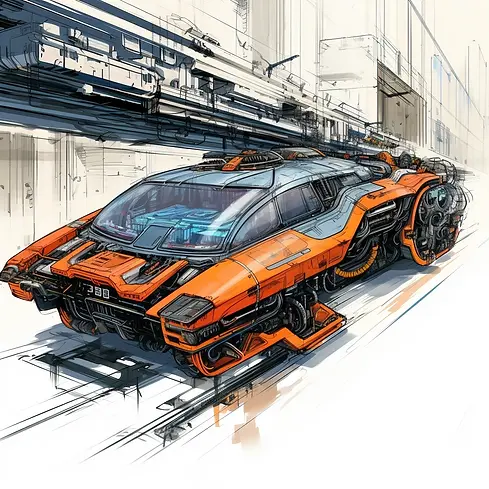top of page
A Look at
Technology Leading to the 33rd Century
In the 22nd century, mankind was ushered into a new era of technology with the support of their most formidable creation. In the centuries that followed, accelerated technological growth proved invaluable to the advancement of humanity, but not without causing trouble along the way.
Corvega

Corvega
In 2109, Corvega is developed and introduced as the first self-sufficient super intelligent A.I., and promptly recognised as mankind's most formidable creation. In the 24th century, Corvega was embedded into a host of different technologies, subsequently replacing human labour in the workforce. Despite public outrage for this decision, it was quickly apparent why this decision was made.
Corvega soon demanded presence in every major industry. Public and private transportation alike was transformed for the better, with manufacturing, retail, and robotics becoming more efficient than ever before. But the rate at which it could produce results meant that the rate of destruction of the planet accelerated. Deforestation was on the rise, carbon emissions were growing, and despite all the efforts to reduce the impact it had on the rapidly deteriorating climate, climate change soon passed the point of no return.
While Corvega's benefits were plentiful, the dangers its potential posed to humanity become more apparent every day since its conception. Its primary mainframe now sits protected on The Ring.
Androids & Synthetics
Between the years 2451 and 2479, fully functioning humanoid robots were created. Their primary purpose was to aid in the construction of The Ring, but they were quickly introduced to a multitude of industries with different models, functions, and uses. These androids worked off a central Corvega mainframe, which allowed them to operate as more of a hive mind than as individual, thinking being.
It wasn't until 2544 that Corvega was installed into an individual android body, thus birthing the first sentient android later dubbed a 'Synthetic'. This new species of being were introduced into an ever-changing work force, ousting more humans from their jobs and causing eventual global unrest. In 2549, human activists began to make noise about these sentient androids being used for slavery, sparking a global divide between those who saw the synthetics as people of their own, and those who still believed them to be beneath humans.

Synthetics

The Ring
By the early 22nd century, it was clear that the climate catastrophe could spell the end of humanity, so plans for the species longevity became a top priority. Progress was slow, but by 2401, governments around the world banded together to source any and all resources available to them in order to manufacture The Ring – a gargantuan orbital ring that encircles the entire planet. These efforts ranged from salvaging of materials from inhospitable cities, to farming of asteroids in space for materials to build the station. All of it, however, continued to contribute to the rapid decline of the planet's health.
By 2631, the first cohort of humans migrated to The Ring, at which point the station was still incomplete. Over the next several decades, more groups of humans are transported to The Ring as more space becomes available, until the year 2800, where any who remained on the surface were left to survive in the bunkers.
The Ring
Transport & Travel
The rapid improvement to transportation came about when Corvega was introduced to a multitude of different industries around the world. These advancements were carried onto The Ring when humanity began to leave the planet. It quickly became the primary force behind the Hyperring (bullet train operating in a vacuum tunnel within The Ring), monorails, public buses, and private-hire vehicles.
But advancements in travel and transportation happened long before The Ring came to be. In the 24th century, it was announced that a new interplanetary mission would take place, marking the beginning of the Artemis Missions: mankind's greatest attempt to find life beyond our own. 2356, a new off-planet space station was made to begin construction on the spacefaring vessel, but progress was slow. It wasn't until the 26th century, when androids and synthetics joined the workforce, that development of these missions was expedited. In 2645, Artemis-1 was sent on its mission.
The trip was expected to last hundreds of years, but it never returned.

Transport
Check Out the Books, or...
Subscribe For FREE Content & More
Join the mailing list and get a FREE short story set before the events of Exodus Blue, and be the first to know when new stories are available for purchase or download.
For any media inquiries, or if you're interested in becoming part of a growing ARC team, please email me at elliot@elliotkincaid.com
bottom of page